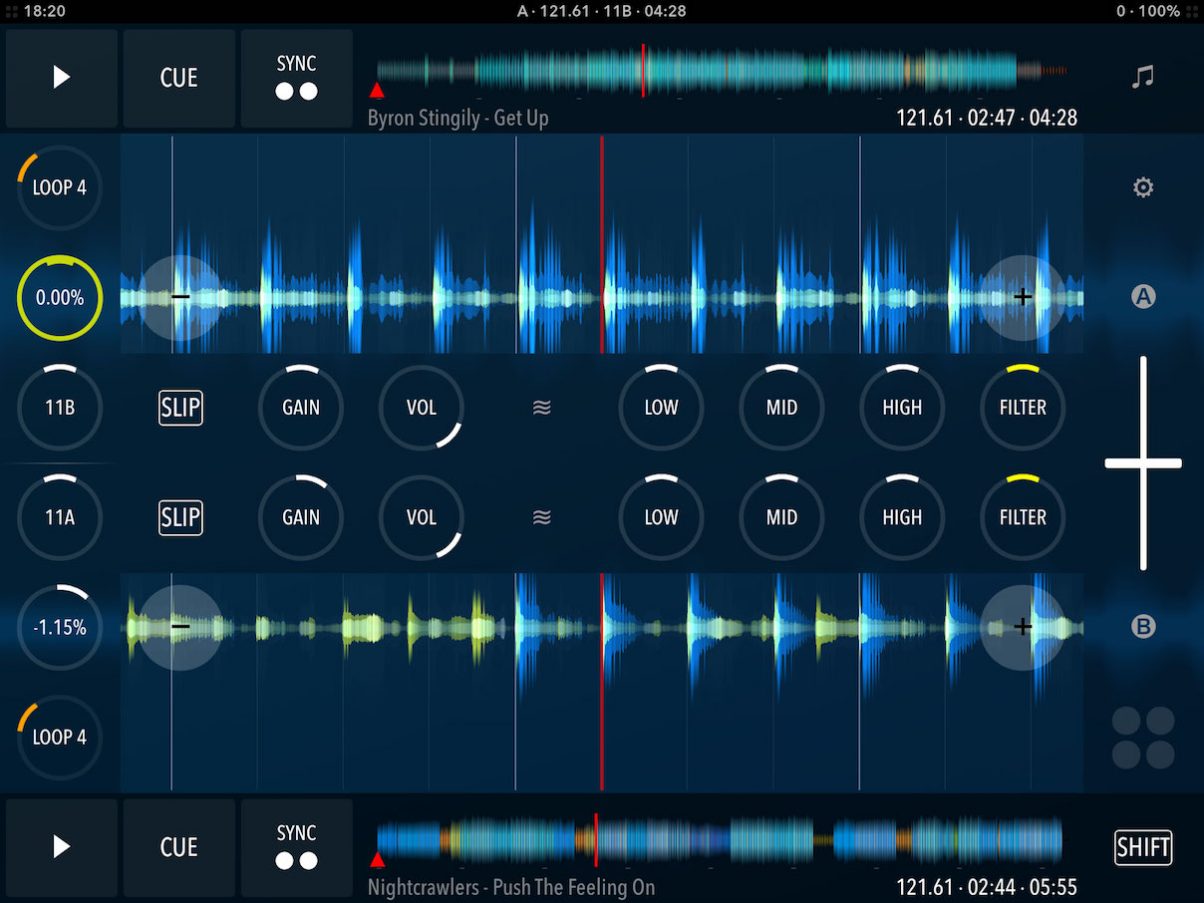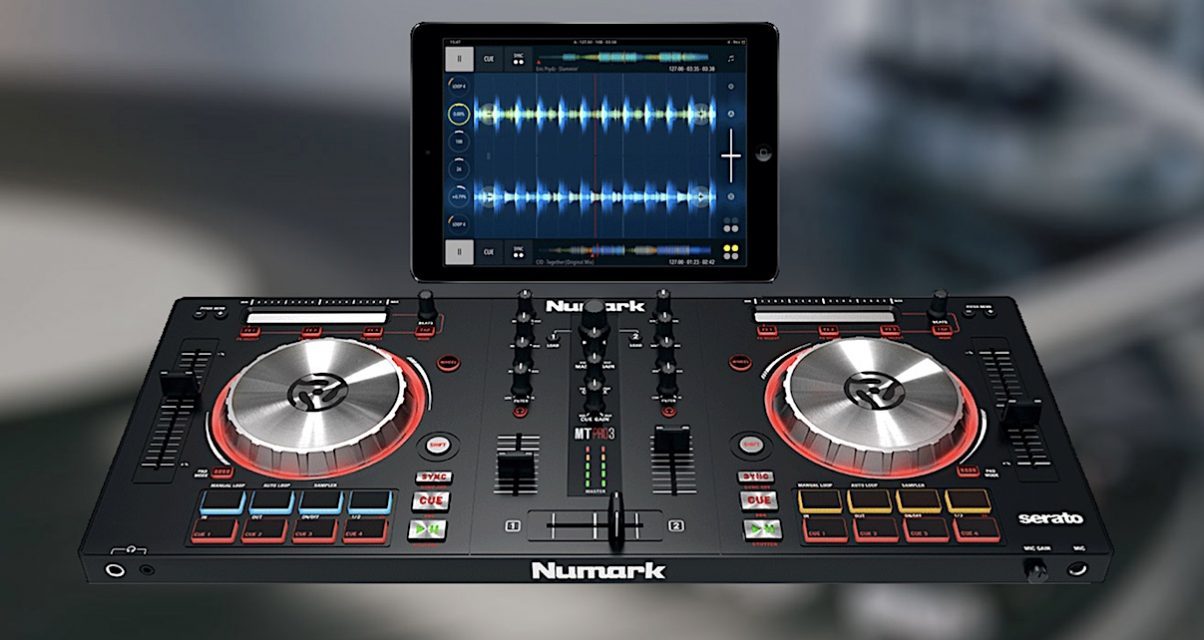The Lowdown
A new “Modern” waveform view, Stems, solid stability, and impeccable sound confirm this is a contender for pros interested in a powerful and reliable platform for iOS. But with many features bound to a monthly subscription model or a hefty one-time fee, will more DJs make the commitment? The absence of most features that make the app truly pro make it a rather crippled version intended for bedroom DJs only.
Video Review
First Impressions / Setting up
As the first “pro” version, DJ Player Pro 9 has its key components reworked from its previous incarnation into a matured interface. Gone are the graphics that looked straight out of Star Trek: The Next Generation – instead there’s now a cleaner GUI that gives more definition to the control zones.

By default, you have a standard two-deck layout in the “Classic” view (there’s also an alternate “Modern” view, but more on that in a bit. When a deck is loaded, you’ll see detailed spectral waveforms, and the decks display EQ, transport, and looping functions. Useful track info like BPM, key, and pitch percent are all in one place – no longer is this information scattered up top and to the side in fine print. And there’s the addition of handy, albeit minimal level meters, something that was absent before.
In Use
New and reworked interfaces
DJ Player Pro now features two different “Performance” views. The default “Classic” view is slightly more geared towards standalone and DVS users, the Serato-style deck platters and vertical waveforms feeling instantly familiar. The inclusion of both beat-plus-tempo and tempo-only Sync types will also make Serato users happy. And the tempo-only variant is quite handy for using Sync with tracks that have beatgrid issues after analysis, as it does not sync track phase.
The new “Modern” view really gives the track waveforms the spotlight and will likely be the style of choice for controller DJs who won’t need to use most controls directly on the screen. Like the Classic view, everything you see here is built on a mirror-image principle, only here things get a little trickier on the horizontal axis. To the far left in between both waveform decks, there’s a tiny eight-circled button that reveals minimal yet complete access to the decks’ FX, gain, volume, EQ, filter, cue points, and even stem level. As in previous versions, both views also translate well to portrait mode (so owners of a Numark iDJ Pro, for example, can also explore the new layouts).
But if you consider that an app’s functions need to be as accessible on its own as they are with external gear, there’s still room for improvement. This version is much tighter but depending on which view one prefers, some might find the persistent need to hold Shift to access basics like deck volume, headphone cue, or gain a little cumbersome – unless they’re mapped to dedicated controls on connected hardware.
Navigating the Library is relatively fast and simple. If you make use of their DJ Cloud service, you don’t even need to remember if the track you want was on the device or in the cloud since they can both be linked. Deezer and Dropbox users can sync up their accounts here, and if you use your own network for storage, DJ Player Pro can connect to this as well.
Stems

When Native Instruments launched its Stems open file format, the original vision was to have developers embrace the format in their own projects, so it’s great to see that DJ Player Pro 9 is the first DJ software for iOS to support the format.
When a stem.mp4 file is loaded onto a deck, you can access its individual stem tracks by holding the shift button and selecting Stems from the menu. This brings up the level and filter controls for each stem track with the Stem track name metadata neatly labeled onto each level knob. And to access their respective kill switches, you guessed it: hold shift to reveal.
What’s great here is you can zoom in and out of the stacked waveforms or just collapse them when you can’t remember which waveform is the drums and you just need to see the downbeat. Each stem has its own dedicated filter but on the other hand, using FX with them doesn’t seem very useful as the kill buttons only serve to bypass the stem from whatever effect is in use.
Conclusion
iMect has truly stepped up to the plate with DJ Player Pro 9. It’s a huge improvement in terms of design and usability. But while it’s true the app has managed to elegantly reinvent itself without losing its core identity, this might not be a selling point for everyone – iMect has radically revamped the GUI before and most software-based DJs won’t fancy the threat of a drastic GUI revision at any major version. And there’s also the learning curve behind the regular need for holding the Shift button to access key controls.
And then there are the payment options. Though the work put in merits a pro price point, iMect have largely favoured a monthly subscription-based model. It’s always risky implementing this kind of software licence but DJ Player isn’t exactly alone, with several DJ software platforms nowadays offering this option.
But there is no doubt this is a powerful and impressive app and DJ Player Pro could easily be adopted by DJs who need a compact set-up for regular gigs in extremely tight DJ booths (iPads don’t get sticky keyboards from beer spills), or even as part of a full club-ready set-up for DJs looking for a more tactile and portable alternative to the laptop.
Until recently, DJing with mobile devices was an unlikely option for serious gigs due to limited functionality and integration with external pro gear. But with the impressive appearance of Apple’s iPad Pro and apps like Algoriddim’s djay Pro, DJ Player Pro 9 is the latest to flaunt its plumage in the bid to change popular perception that iPad apps are mere toys for the casual wannabe.
If the currently accepted notion that iOS apps are on a lower software tier than their desktop counterparts continues to change, it will be interesting to see just how far DJ Player Pro goes from here.




